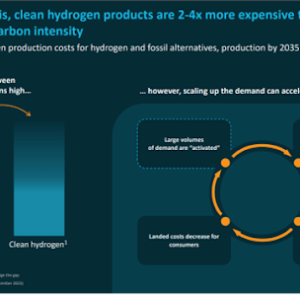-
Scaling a Global Hydrogen Ecosystem
Date posted:
-
-
-
Post Author
Greg Kelsall
-
-

Industrial customers are finding it difficult to commit to using hydrogen due to its high prices. This is according to a new report from the Hydrogen Council and McKinsey & Company entitled Emerging Trade Corridor for Hydrogen and its Derivates.
The report maintains that clean hydrogen products are 2-4 times more expensive than fossil fuel alternatives, making it difficult for industrial consumers to commit to using hydrogen for fear of losing their competitive edge in downstream markets. However, the writers argue that if demand can be scaled up, a decrease in cost could accelerate. They also say combining mechanisms such as CfDs, tax credits, and carbon penalties (that support the cost-competitiveness of clean products) with safeguards against carbon leakage would facilitate the large investments required in hydrogen technologies, underpinned by offtake commitments.
To kick-start the scaling of a global hydrogen ecosystem, the report identifies three key steps to help unlock hydrogen technology:
- Ensure more clarity, certainty, and support for demand drivers, with focus on accelerating the implementation of the announced demand-pull measures key to kick-start the market and secure the first 3-7 MtH2/y of mandated demand volumes by 2030.
- Retrofit, repurpose, and build infrastructure to enable inter-regional corridors and allow technologies to compete without ‘picking winners’ ensuring the most cost-effective and sustainable solutions thrive.
- Establish aligned and consistent global market rules, industry standards, and mutually recognised certification schemes to support the development of an international hydrogen market.
The report also states that cross-border trade of hydrogen and its derivatives could save $3.7 trillion in investment costs by 2050. The writers explain that connecting high-demand energy areas with regions that can supply low-cost clean hydrogen could cut total system costs by 30% compared to a scenario where all hydrogen is produced and consumed locally. Therefore, $25 can be saved for every $1 invested in hydrogen trade infrastructure through to 2050.
